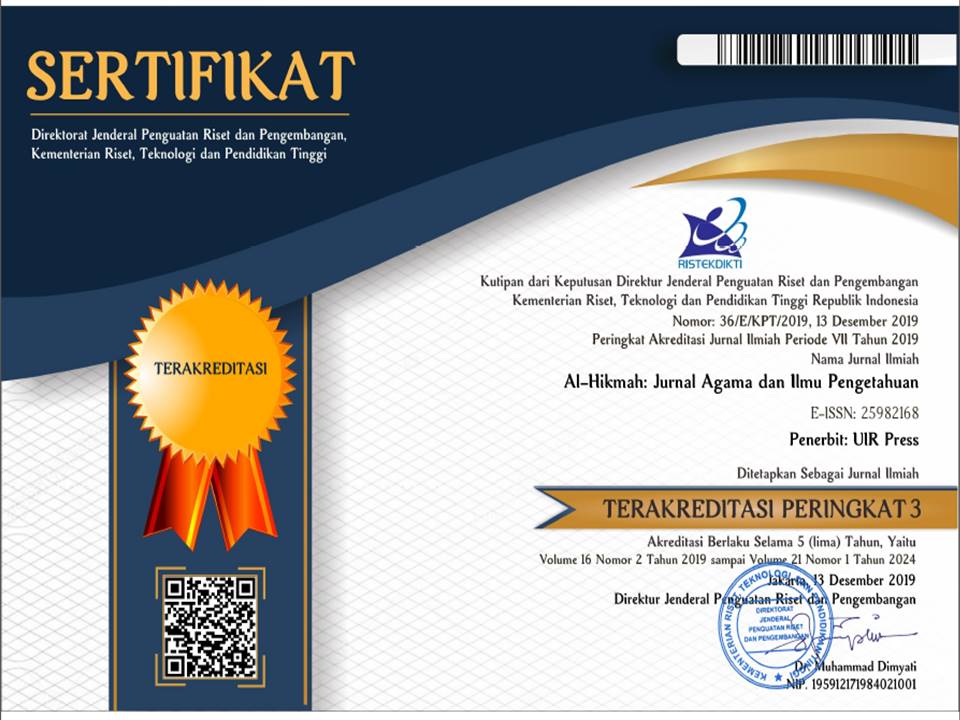Solusi Gangguan Smartphone Addiction Berdasarkan Pendekatan Psikologi Islam
DOI:
https://doi.org/10.25299/al-hikmah:jaip.2021.vol18(1).6652Keywords:
Smartphone Addiction, Daya Juang, Prestasi Akademik, Siswa, RemajaAbstract
ABSTRACT
Adolescent at this point very close to the rapid technological growth. Adolescent are a primary target for debatable features inside the smartphone, which makes it easier for the youth to become addicted to the smartphone usage, and this of course, also encourages learning in the youth to become weak that results in a drop in academic achievement. Previous studies have explained that adolescents depend heavily on their smartphones, as well as on the features available inside the smartphone. It also certainly had an impact on academic achievement, their ability to achieve good academic achievement was weak, they were not motivated to get a good achievement on their academic. In this case, youth should pay more attention to the time of their smartphone use, youth should also have internal motivation, parents, teachers, and friend so that youth have the proper fighting power to improve academic achievement. On the other side, a homepical method is used as a solution to the smartphone. The application of reading a digital Quran application in away of data collection, data reduction, data presentation, and a withdrawal of conclutions or otherwise know by miles and huberman interactive models has yielded results from where reading the Quran could direct youth to use smartphones on positive things. Students or adolescents affected by smartphone addictions in the interview express better changes in themselves and want to continue reading Quran applications on their order to break from their smartphone addictions.
Keywords: Smartphone Addiction, Fighting power, Academic Achievement, Adolescence
ABSTRAK
Remaja pada zaman sekarang merupakan orang yang sangat dekat dengan perkembangan teknologi yang sangat pesat. Remaja merupakan sasaran utama pengembangan fitur-fitur yang ada di dalam Smartphone, dengan ini memudahkan remaja menjadi candu pada penggunaan Smartphone dan tentunya hal ini juga menimbulkan daya juang belajar pada remaja menjadi lemah yang mengakibatkan penurunan pada prestasi akademik. Artikel ini menggunakan metode studi kepustakaan sebagai pendekatan kualitatif deskriptif yang menggambarkan fenomena adiksi smartphone (ponsel pintar) pada siswa atau remaja. Dalam hal ini, remaja harus lebih memperhatikan waktu penggunaan Smartphone mereka. Remaja juga harus mendapatkan metode belajar yang tepat untuk mengatasi adiksi ponsel pintar. Selain itu, metode keislaman dipergunakan sebagai solusi mengatasi smartphone addiction. Penerapan membaca aplikasi al-Quran digital yang dilakukan dengan cara pengumpulan data, reduksi data, penyajian data, dan penarikan kesimpulan atau yang dikenal dengan teknik analisis data pada konsep miles and huberman interactive model berhasil menunjukkan hasil tentang penerapan membaca al-Quran mampu mengarahkan remaja untuk menggunakan smartphone kepada hal yang positif. Siswa atau remaja yang terkena adiksi smartpone menyatakan perubahan lebih baik pada diri mereka dan ingin terus membaca aplikasi al-Quran pada ponsel mereka untuk dapat berhenti dari kecanduan smartphone mereka.
Kata Kunci: Smartphone Addiction, Daya Juang, Prestasi Akademik, Remaja
Downloads
References
Agesti, L. P., Fitryasari, R., Armini, N. K. A., & Yusuf, A. (2019). Hubungan smartphone addiction dan Self-efficacy dengan prestasi akademik pada remaja. Jurnal Keperawatan Jiwa, 1(1), 1-6.
Agustina, T. S., & Komalasari, P. T. (2014). Kecerdasan Adversiti (Adversity Quotient) Berdasarkan Jender pada Mahasiswa yang mengikuti Executive Territory Program-program mata kuliah Managemen Usaha kecil dan menengah. Jurnal Ekonomi dan Bisnis Airlangga (JEBA), 24(3), 206-215.
Alt, D., & Boniel-Nissim, M. (2018). Parent-Adoles-cent communication and problematic internet use: The mediating role of fear of missing out (foMO). Journal of Family Issues, 39(13), 3391-3409.
Asril (2011). Faktor-faktor yang mempengaruhi Prestasi Belajar siswa SMA Hang Tuah 1 Jakarta. Universitas Islam Negeri Syarif Hidayatullah.
Bandura, A. (1997). Self-efficacy: The exercise of control. New York, NY: Freeman and Co
Chen, Y. F. (2006). Social phenomena of mobile phone use: An exploratory study in Taiwanese college students. Journal of Cyber Culture and Information Society, 7, 219-244.
Cutino, C. M., & Ness, M. A. (2017). Restricting mobile phone access during homework increases attainment of study goals. Mobile media & Communication, 5(1), 63-79.
Fatmahanik, U. (2018). Pola Berfikir ditinjau dari Adversity Quotient. Jurnal Kodifikasia, 12(2), 275-287.
Fathurahman, P. (2011). Metode Penelitian Pendidikan. Bandung: Pustaka Setia.
Hasanah, U., Hijrianti, U. R., & Iswinarti (2020). Pengaruh smartphone addiction terhadap perilaku agresif pada remaja. Proyeksi: Jurnal Proyeksi, 15(2), 182-191.
Hidayat, W., & Sariningsih, R. (2018). Matematis dan Adversity Quotient siswa. Nasional Pendidikan Matematika, 2(1), 109-118.
Huang, L., Krasikova, D. V. & Liu, D. (2016). I can do it, so can you: The role of leader creative self-efficacy in facilitating follower creativity. Organizational Behavior and Human Decision Processes. Elsevier Icn., 132, pp. 49-62.
Julian, A. (2018, febuari). Digital 2020: Penggunaan internet Indonesia dalam angka. Diunduh dari: https://m.cyberthreat.id/read/5387/Digital-2020-Pengguna-Internet-Indonesia-dalam-Angka
Kwon, M., Kim, D. J., Cho, H., & Yang, S. (2013). The Smartphone Addiction scale: development and validation of a short version for adolescents. Plos one, 8(12), e83558.
Kwon, M., Lee, J. Y., Won, W. Y., Park, J. W., Min J. A., Hahn, C., & Kim, D. J. (2013). Development and validation of a Smartphone Addiction scale (SAS). Plos one, 8(2), e56936.
Liu, D., Kirschner, P. A., & Karpinski, A. C. (2017). A meta-analysis of the relationship of academic performance and social network site use among adolescents and young adults. Computers in Human Behavior, 77(9), 148-157.
Lubis, L. T., & Sati, L., & Adhinda, N, N., & Yulianirta, H., & Hidayat, B. (2019). Peningkatan kesehatan mental anak dan remaja melalui ibadah keislaman. Al-Hikmah: Jurnal Agama dan Ilmu Pengetahuan. 16(2). 120-129.
Mayasari, D. (2019). Pengembangan Bahan ajar segitiga dengan pendekatan Open Ended untuk Meningkatkan Kemampuan Pemecahan Masalah Matematika. Jurnal Inomatika, 1(2), 99-109.
Mayasari, D., & Pagiling, S. L. (2020). Efektifitas pembelajaran problem solving ditinjau dari daya juang dan hasil belajar siswa. Jurnal pendidikan matematika RAFA. 6(2). 134-145.
McCoy, B (2013). Digital distraction in the classroom: Student classroom use of digital devices for non-class related purpose. College of Journalism & Mass Communications, 4, 5-15.
Mukhtar, P. D., & Pd, M. (2013). Metode Praktis Penelitian Deskriptif Kualitatif. Jakarta: GP Press Group.
Nakaya, A. C. (2014). Internet and sosial media addiction. Sandiego, CA: Reference Point Press.
Oberst, U., Wegmann, E., Stodt, B., Brand, M., & Chamarro, A. (2017). Negative concequences from heavy social networking in adolescents: The mediating role of fear of missing out. Journal of Adolescence, 55(12), 51-60.
Olan., Idi, A., Zainuri, A., & Sandi, A. (2019). Implementasi Aplikasi Al-quran Digital pada siswa Kecanduan Gadget. Nazhruna: Jurnal Pendidikan Islam, 2(3), 330-349.
Sarwar, M., & Soomro, T. R. (2013). Impact of Smartpones on society. European Journal of Scientific Research, 98(2), 216-226.
Salomon, A., & Ben-David Kolikant, Y. (2016). High-school student perceptions of the effects of non-academic usage of ICT on the their academic achievements. Computer in Human Behavior, 64(7), 143-151.
Subagio, A. W., & Hidayati, F. (2017). Hubungan antara kesepian dengan adiksi smartphone pada siswa SMA negeri 2 Bekasi. Jurnal empati, 6(1), 27-33.
Seo, D. G., Park, Y., Park, J., & Kim, M. K. (2016). Mobile phone dependency and its impacts on adolescents social and academic behaviors. Computers in Human Behavior, 63(5), 282-292.
Utami, A. N. (2019). Dampak negatif adiksi penggunaan smartphone terhadap aspek-aspek akademik personal remaja. Perspektif Ilmu Pendidikan, 33(1), 1-14.
Wardani, W. S. K., & Saidiyah, S. (2016). Daya Juang Mahasiswa Asing. Psympathic: Jurnal Ilmiah Psikologi, 3(2), 213-224.
White, A. G., Buboltz, W., & Igou, F. (2010). Mobile phone use and sleep quality and length in college students. International Journal of Humanities and Social Science, 1, 51-58.
Wijanarko, J. (2017). Pengaruh pemakaian gadget dan perilaku anak terhadap kemampuan anak taman kanak-kanak happy holy kids Jakarta. Jurnal Institut Kristen Borneo, 2, 1-40.
Yun, I., Kim, S., & Kwon, S. (2016). Low self-control among south Korean adolescents: A test of Gottfredson and Hirschi’s generality hypothesis. International Journal of Offender Therapy and Comparative Criminology, 60(10), 1185-1208.
Zahra, Y., & Hernawati, N. (2015). Prokrastinasi akademik menghambat peningkatan prestasi akademik remaja di wilayah perdesaan. Jurnal Ilmu Keluarga & Konsumen, 8(3), 163-172.
Zhang, Y., Qin, X., & Ren, P. (2018). Adolescents' academic engagement mediates the association between Internet addiction and academic achievement: The moderating effect of classroom achievement norm. Computers in Human Behavior, 89, 299-307.






